Top 7 Referral Widgets for Shopify That Actually Drive Conversions
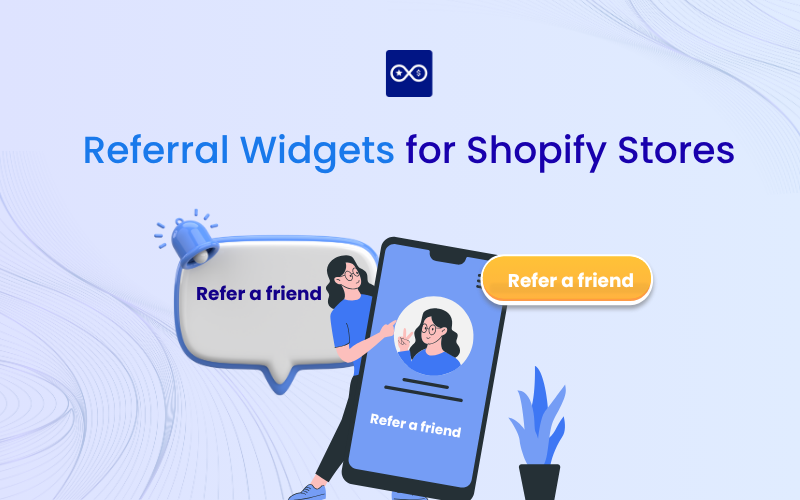
Most Shopify stores understand that word-of-mouth sales are effective, yet few can harness them at scale. Since 92% of shoppers trust personal recommendations, the real challenge isn’t awareness but finding a way to automate it effectively. That’s why referral widgets have become essential; they’re lightweight, conversion-driven tools that turn happy customers into active promoters right inside your store. In this guide, you’ll discover the top 7 referral widgets tool for Shopify in 2026, carefully ranked by setup speed, UX quality, reward flexibility, and analytics depth, so you can choose tools that not only look great but actually drive conversions.
>> See more:
- 20+ Referral Program Ideas For eCommerce That Definitely Works in 2026
- How to Set Up a Referral Program on Shopify? (With Excel Checklist)
- How To Promote a Referral Program For Your Shopify Stores? (15+ Free & Paid Tactics That Work)
What Is a Referral Widget and Why It’s Crucial for Shopify Stores
Definition & Types
A referral widget is an interactive interface element that enables customers to share your store with friends, track referral progress, and claim rewards without leaving your site or disrupting their shopping experience.

Referral widgets come in several formats:
- Inline Referral Widget: Embedded directly on a webpage, prominently displayed for easy sign-up and sharing.
- Pop-up Referral Widget: Appears as a pop-up window to catch visitors’ attention.
- Slide-in Referral Widget: Slides into view from the side or bottom of the page.
- Floating Referral Widget: Stays visible as a floating element on the webpage.
- Exit-Intent Referral Widget: Appears when the user is about to leave the site, encouraging last-minute participation.
- Embedded Referral Form: A simple form integrated into a page for users to enter referral details.
- Referral Link Generator Widget: Allows users to generate and share personalized referral links.
- Social Sharing Referral Widget: Focuses on sharing referrals via social media platforms.
Each widget typically includes functional elements like one-click sharing buttons (email, SMS, WhatsApp, social media), unique referral link generators, progress trackers, and reward visualization.
Why Widgets Boost Conversions?
The psychology is simple: reducing friction increases action. Traditional referral programs that require customers to navigate through multiple pages, manually copy links, or remember to share later see participation rates below 5%.
Referral widgets flip that equation by:
- Meeting customers where they are: Appearing at high-intent moments (right after checkout, during account browsing, or when viewing order confirmations)
- Simplifying the sharing process: One-click sharing eliminates the cognitive load and time investment
- Providing instant gratification: Real-time reward displays and progress tracking gamify participation
- Creating persistent visibility: Floating widgets maintain awareness across the entire customer journey
Placement & UX Matter: The Friction/Gain Equation
Where and how you display referral widgets directly impacts conversion rates. Consider this framework:
High-Conversion Placements:
- Post-checkout/thank-you pages: Customers are in a positive state and already engaged
- Customer account dashboards: Natural location for repeat visitors to access their referral status
- Site-wide floating buttons: Maintains visibility without disrupting browsing

Lower-Conversion Placements:
- Buried in footer menus: Requires active seeking behavior
- Standalone pages without traffic drivers: No one visits if they don’t know it exists
The friction/gain equation is straightforward: Every additional click, form field, or navigation step reduces participation exponentially. The most effective referral widgets require zero to one click from awareness to sharing. Less friction equals higher conversion, it’s that simple.
The Top 7 Shopify Referral Widgets Tools for 2026
1. Bloop Referrals & Affiliates (Editor’s Pick)
“The easiest and most affordable referral solution with instant setup and highest conversion impact.”
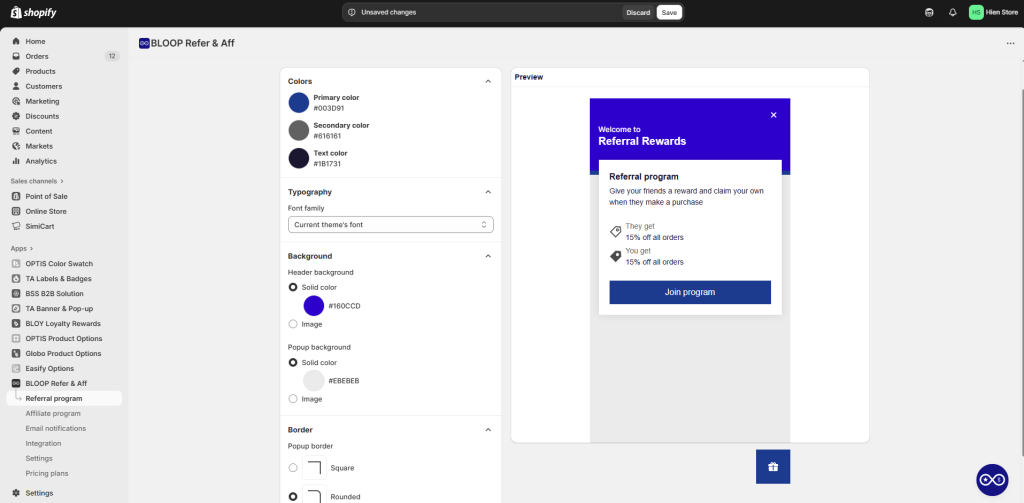
Bloop stands out as our top recommendation for Shopify merchants who want a referral program running today, not next quarter. Designed specifically for e-commerce, Bloop eliminates the complexity that bogs down other platforms.
Key Features:
- Branded referral pages and pop-ups that match your store design out of the box
- Customer account extension integration extends referral access directly in Shopify customer accounts
- Flexible two-sided reward system with automatic application at checkout
- Professional fraud controls including IP filtering and self-referral blocking
- Native Shopify integration plus connectivity to Klaviyo, Mailchimp.
Why It Converts:
Bloop’s widget appears at exactly the right moment, immediately after purchase when customer satisfaction peaks. The automatic enrollment means every customer becomes a potential advocate without thinking about it.
Best For: Shopify merchants of all sizes seeking fast setup, affordability, and proven conversion rates without sacrificing customization.
2. Yotpo Referral Widget
“Enterprise-grade referral marketing with no-code setup and advanced customization.”
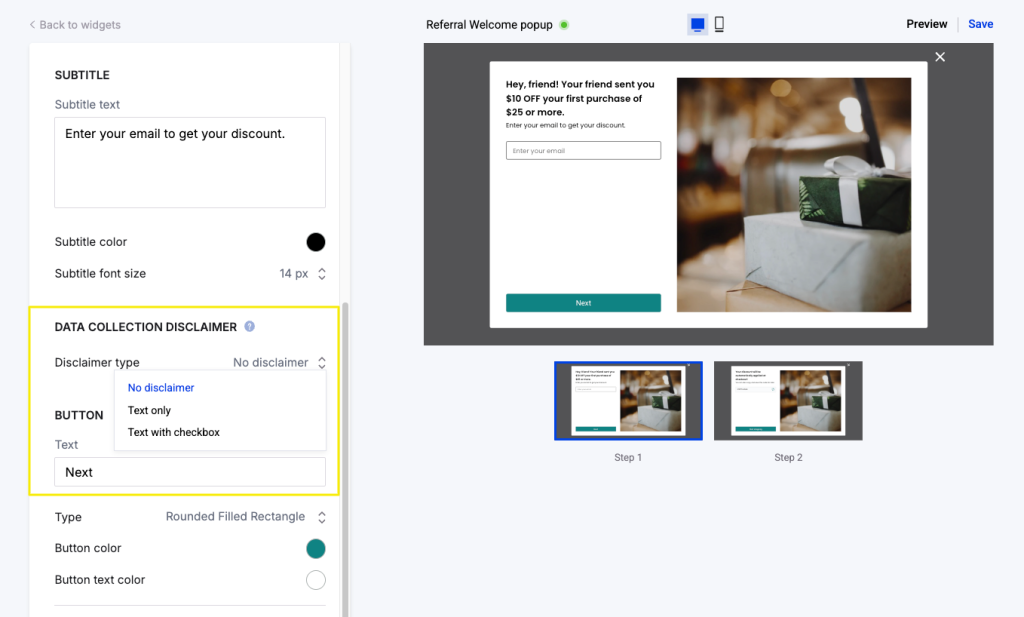
Yotpo brings its loyalty and reviews expertise to referral marketing with a robust widget builder.
Key Features:
- Rewards Page Builder with drag-and-drop customization
- Multi-channel sharing via WhatsApp, SMS, email, and direct link copying
- Automatic reward delivery at checkout with no manual processing
- Advanced design controls for text, colors, layouts, and responsive behavior
- Integration with Yotpo’s loyalty ecosystem for unified customer engagement
Why It Converts:
The visual page builder makes it easy to create high-converting referral experiences without developer resources. The automatic reward redemption removes friction at checkout.
Best For: Growing brands already invested in Yotpo’s ecosystem or those requiring extensive design control.
3. Viral Loops for Shopify
“Campaign-focused referral marketing with viral mechanics and deep analytics.”
Viral Loops specializes in creating referral campaigns with built-in virality through gamification.
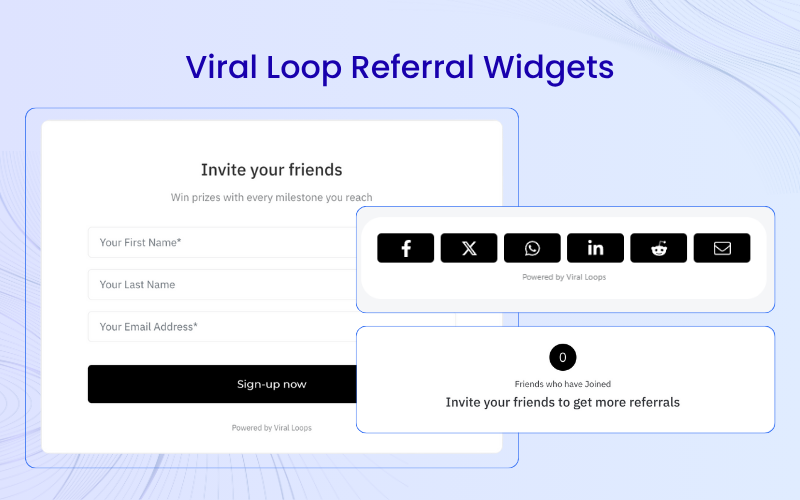
Key Features:
- Pre-built campaign templates including milestone challenges, leaderboards, prelaunch waitlists, and newsletter referrals
- Segment-specific widget designs allowing different experiences for different customer groups
- Advanced analytics showing viral coefficients, sharing patterns, and campaign performance
- Strong email integration for newsletter-driven commerce brands
Why It Converts:
The milestone and leaderboard templates tap into competitive psychology, driving higher engagement rates. Brands running limited-time campaigns see particularly strong results.
Best For: Brands launching new products, running seasonal campaigns, or integrating referral marketing with content/newsletter strategies.
4. ReferralHero Widgets
“Modular widget library for maximum flexibility across customer journeys.”
ReferralHero offers the most extensive widget collection, allowing you to create layered referral experiences.
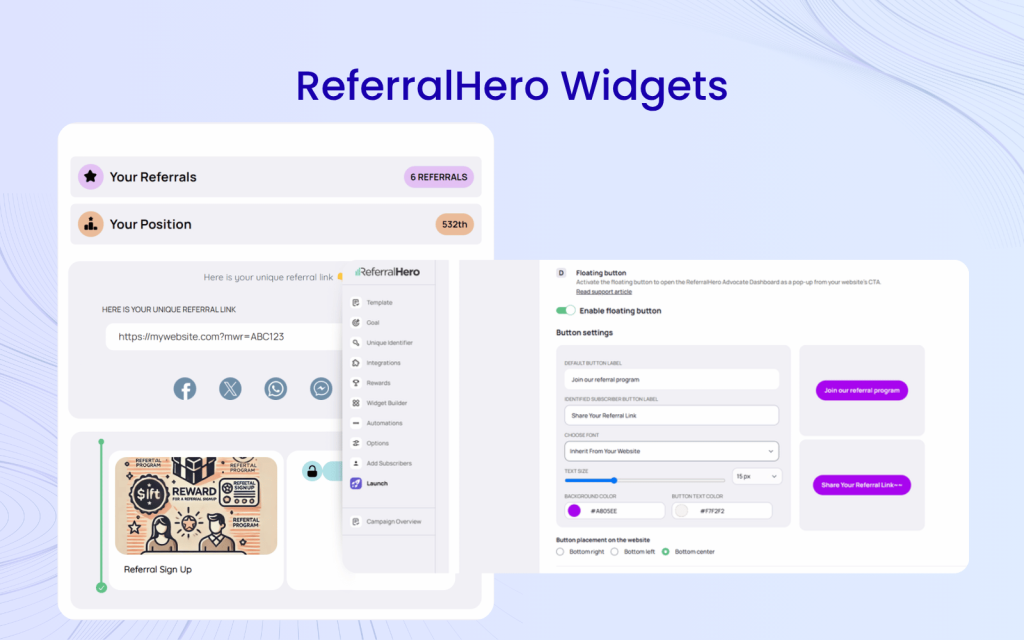
Key Features:
- Multiple widget types: Advocate dashboard, floating action button, sign-up forms, sharing panels, welcome banners
- Logged-in vs. logged-out experiences with different widget displays based on user state
- Extensive behavioral controls to trigger widgets based on actions, page views, or time on site
- White-label options for complete brand control
Why It Converts:
The modular approach allows sophisticated referral journeys that meet customers at multiple touchpoints. Power users combine widgets for compound effects.
Best For: Established stores with technical resources seeking maximum control over referral UX and customer journey optimization.
5. Referral Factory Widget
“Highly customizable floating and embedded widgets compatible across platforms.”
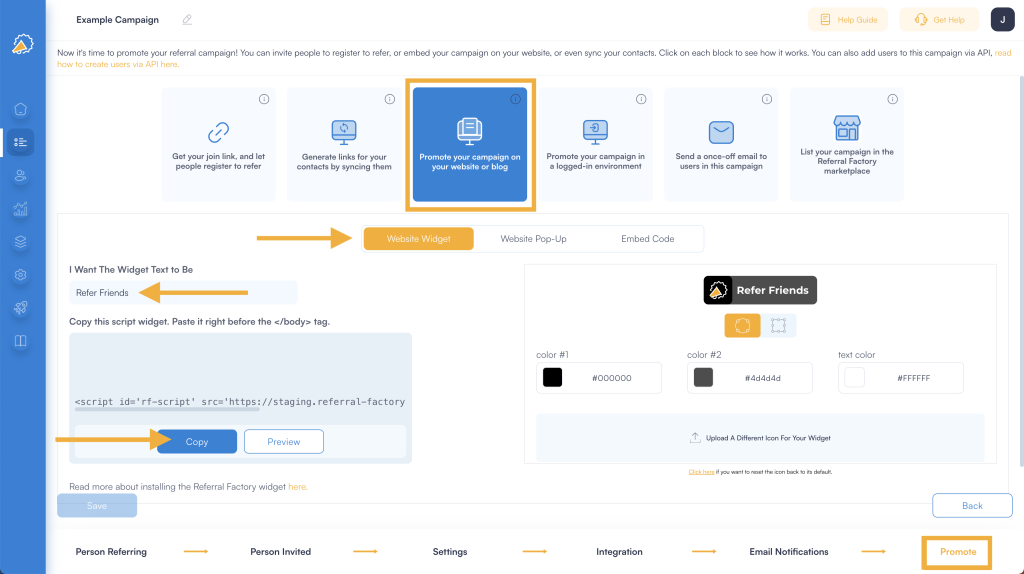
Referral Factory provides universal widget compatibility, making it ideal for Shopify Plus merchants with headless or custom storefronts.
Key Features:
- Floating and embeddable widget options for public or member-only visibility
- Pre-embed customization for text, colors, icons, and positioning
- Wide platform compatibility including Webflow, WordPress, Squarespace alongside Shopify
- Robust API for custom implementations
Why It Converts:
The floating widget maintains persistent visibility without disrupting UX, leading to consistent engagement across browsing sessions.
Best For: Shopify Plus merchants, headless commerce implementations, or brands operating across multiple platforms.
6. Genius Referrals Link Sharing Widget
“Maximum accessibility with extensive social platform support and technical flexibility.”
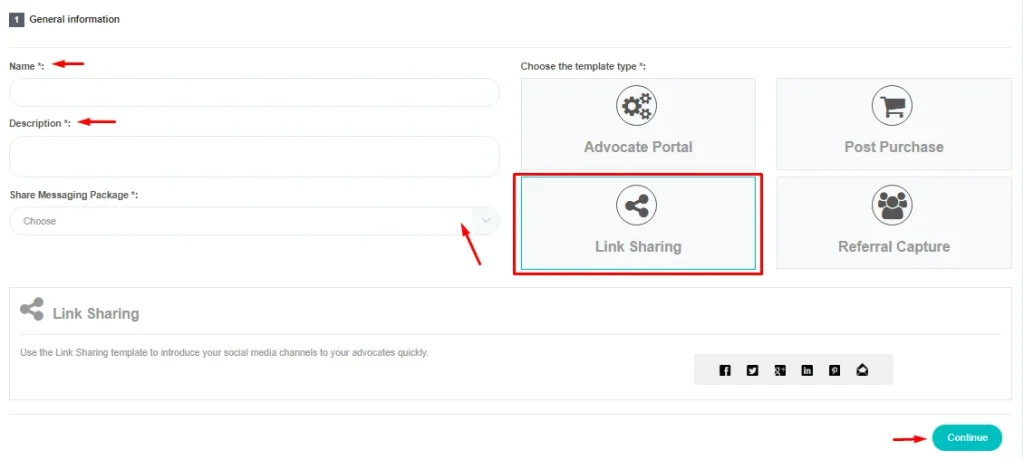
Genius Referrals prioritizes sharing channel diversity and technical customization.
Key Features:
- Widget placement options: Dashboard panels, menu integration, footer, overlay, pop-up
- Extensive social sharing: Facebook, Twitter, WhatsApp, Telegram, LinkedIn, SMS, email
- Bootstrap/CSS/HTML5 architecture for advanced custom integrations
- Developer-friendly APIs and webhooks
Why It Converts:
The wide range of sharing channels ensures customers can use their preferred communication method, removing platform friction.
Best For: Technical teams, international brands needing diverse social platforms, or stores requiring custom widget implementations.
7. Beehiiv Custom Referral Widget (for Creator/Newsletter Stores)
“Purpose-built for newsletter-driven commerce with dynamic personalization.”
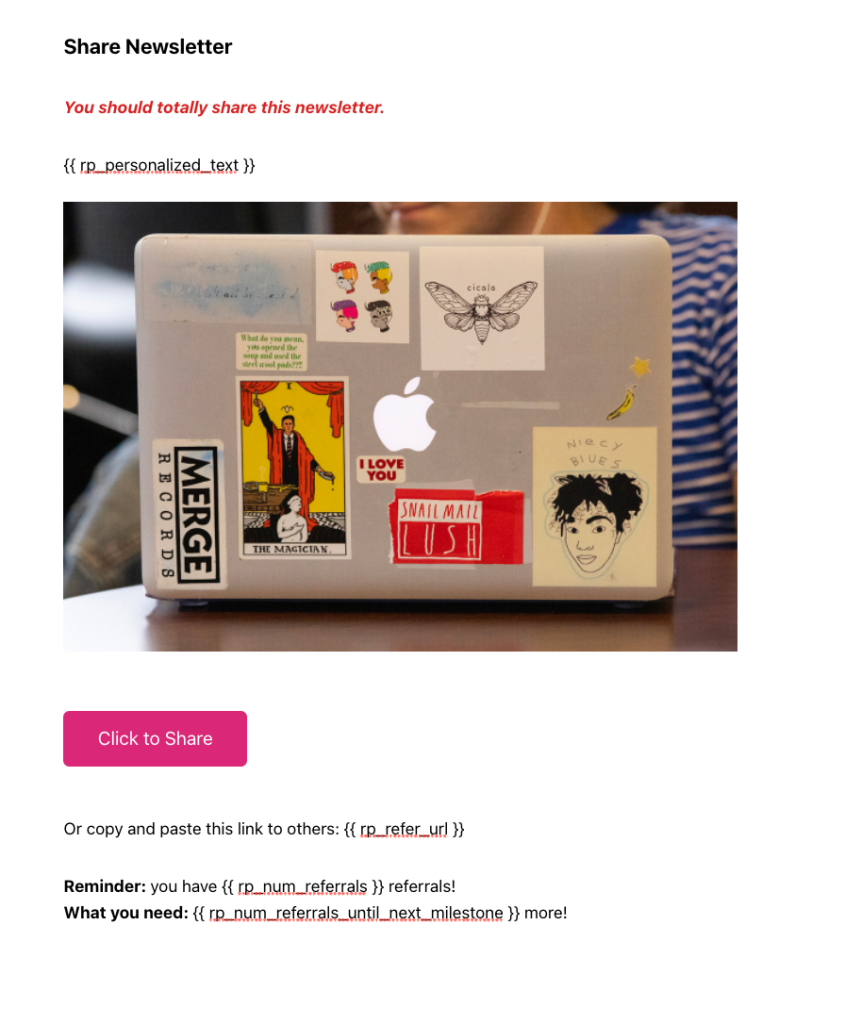
Beehiiv’s referral widget bridges content and commerce, ideal for creator economy Shopify stores.
Key Features:
- Merge tags for dynamic personalization based on customer data
- Milestone reward displays showing progress toward tiered incentives
- Content-first design optimized for newsletter and blog contexts
- Progress visualization with customizable graphics and copy
- Deep analytics connecting content engagement to referral behavior
Why It Converts:
The content-native design feels organic rather than promotional, driving higher engagement from newsletter subscribers who expect value-first experiences.
Best For: Creator-led brands, newsletter commerce businesses, content-driven Shopify stores with engaged subscriber bases.
Quick-Reference Comparison Table
| Widget | Setup Speed | UX Quality | Reward Flexibility | Analytics Depth | Best Use Case |
| Bloop | ⚡ Instant | ⭐⭐⭐⭐⭐ | Two-sided, specific segment | Real-time, revenue tracking | Fast launch, all store sizes |
| Yotpo | 1–2 days | ⭐⭐⭐⭐⭐ | Highly flexible | Deep, loyalty-integrated | Yotpo ecosystem users |
| Viral Loops | 2–3 days | ⭐⭐⭐⭐ | Campaign-specific | Viral metrics | Campaign-driven brands |
| ReferralHero | 3–5 days | ⭐⭐⭐⭐⭐ | Fully customizable | Extensive segmentation | Technical power users |
| Referral Factory | 2–4 days | ⭐⭐⭐⭐ | Standard + Custom | Good cross-platform | Multi-platform brands |
| Genius Referrals | 3–5 days | ⭐⭐⭐⭐ | API-driven | Developer-focused | Custom implementations |
| Beehiiv | 1–2 days | ⭐⭐⭐⭐ | Content-aligned | Content + commerce | Newsletter/creator stores |
Practical Tips to Maximize Referral Widget Conversions
Strategic Widget Placement & Timing
Placement drives participation. Research from referral marketing studies shows that widget placement can impact conversion rates by up to 400%. Here’s what works:
High-Impact Placements:
- Post-purchase pop-up: Trigger immediately after checkout confirmation (capitalize on peak satisfaction)
- Thank-you page embed: Include referral widget directly on order confirmation pages with clear reward messaging
- Customer account dashboard: Permanent widget placement in the “My Account” area for ongoing accessibility
- Floating button: Always-visible element in bottom-right corner (test bottom-left for mobile)
Timing Strategies:
- Immediate post-purchase: Strike while excitement is fresh (within 5 minutes)
- 7-day follow-up email: Include referral widget/link in post-purchase satisfaction emails
- 30-day re-engagement: Target customers who haven’t referred with reminder SMS campaigns
- Milestone celebrations: “You’ve been with us for 6 months—share and get $20!”
Case Example: A Shopify supplement brand tested three placements: footer link only (0.8% participation), account dashboard embed (4.2% participation), and floating widget + post-purchase pop-up (11.7% participation). The multi-touch approach generated 14x more referrals than the single footer link.
Optimizing Incentives
Your widget interface should make rewards crystal clear and immediately compelling:
Best Practices:
- Display rewards prominently: “Give $15, Get $15” should be the first thing customers see
- Use specific dollar amounts: “$10 off” converts better than “10% off” in most categories
- Visualize progress: Show “2 of 5 friends referred” progress bars
- Highlight milestone bonuses: “Refer 5 friends = Extra $25 bonus + VIP status”
- Test two-sided vs. one-sided: Data shows two-sided rewards typically generate 40-60% higher participation
Incentive Psychology:
- Reciprocity trigger: “Your friend gets $10” makes sharing feel generous, not sales-y
- Loss aversion: “Don’t miss your $20 credit” outperforms “Earn $20 credit”
- Social proof: “Join 3,247 customers earning rewards” builds legitimacy
Tracking & Fraud Prevention
Protecting program integrity ensures sustainable growth and maintains profit margins:
Essential Fraud Controls:
- IP address blocking: Prevent multiple accounts from same device
- Email domain filtering: Block temporary/disposable email services
- Minimum purchase requirements: Require $50+ order value for reward eligibility
- Manual review queues: Flag suspicious patterns (same shipping address, rapid repeat orders)
- Time delays: Hold rewards for 7-14 days to prevent refund fraud

Analytics to Monitor:
- Conversion rate by traffic source: Identify which channels drive quality referrals
- Average order value comparison: Referred customers vs. organic customers
- Fraud rate: Maintain below 2-3% through active monitoring
- Widget engagement rate: Track views vs. clicks vs. shares to identify drop-off points
Pro Tip: Set up automated alerts when fraud indicators spike, catching issues early prevents revenue loss.
Offsite Program Promotion
Your referral widget shouldn’t exist in a vacuum. Drive awareness through:
Email Campaigns:
- Dedicated referral program announcement email
- Widget/link inclusion in transactional emails (receipts, shipping confirmations)
- Monthly “Your referral stats” updates for engaged advocates
Social Media:
- Instagram Stories highlighting customer referral success (“Sarah earned $150 this month!”)
- Pinned posts explaining program benefits
- Influencer partnerships showcasing referral mechanics
Physical Touchpoints:
- QR codes on product packaging linking to referral widget
- Receipt inserts with referral instructions
- Unboxing experience cards
SMS Marketing:
- Post-purchase SMS: “Love your order? Share with friends → Get $10”
- Birthday/anniversary SMS with bonus referral incentives
Referral Widget FAQs for Shopify Stores
What’s the difference between embedded, floating button, and popup referral widgets?
Embedded widgets are integrated directly into page content (account dashboards, thank-you pages) and remain stationary. Floating buttons appear as persistent elements (usually bottom corner) that follow users as they scroll, maintaining visibility. Pop-ups are timed or triggered overlays that appear over content (post-purchase, exit intent). Floating and popup widgets typically drive 3-5x higher engagement than embedded-only approaches due to increased visibility.
Can I restrict referral widgets to logged-in members only?
Yes. Most quality referral platforms allow you to show widgets only to authenticated customers. This is useful for protecting program exclusivity, preventing abuse, or offering tiered access. You can typically set rules like “display to customers with 2+ purchases” or “hide for wholesale accounts.”
How do I customize the widget to match my store’s branding?
Top referral widgets offer multiple customization levels: basic (colors, fonts, button text), intermediate (layout options, image uploads), and advanced (custom CSS, HTML editing). Bloop, Yotpo, and ReferralHero offer extensive branding controls that don’t require coding, while tools like Genius Referrals provide full CSS access for developers. Always preview your content across both mobile and desktop devices before publishing.
What integrations should I require (Shopify, marketing tools, analytics)?
Essential integrations: Native Shopify (for customer data, product catalog, discount code generation), email platform (Klaviyo, Mailchimp for automated campaigns), analytics (Google Analytics for conversion tracking). Nice-to-have: SMS platforms (Postscript, Attentive), customer service tools (Gorgias for support queries), accounting software (for reward cost tracking). Prioritize integrations that eliminate manual work.
Can I prevent self-referrals and fraud?
Yes, through multiple mechanisms: unique referral links with embedded tracking, IP address filtering to block same-device referrals, email domain restrictions to exclude temporary email services, minimum purchase thresholds before reward eligibility, and manual review queues for suspicious patterns. Top platforms like Bloop include professional fraud controls by default. Expect 1-3% fraud rate as normal; above 5% indicates insufficient controls.
Conclusion: Transform Customers Into Your Best Sales Channel
The most successful Shopify stores don’t just install referral widgets, they optimize placement, test incentives, prevent fraud, and continuously promote their programs across all customer touchpoints. The right referral widget, placed strategically and backed by compelling incentives, can generate thousands in monthly revenue with minimal ongoing effort.
Your customers already love your products. Now give them an easy, rewarding way to share that love and watch your referral revenue grow.
Ready to get started? Install Bloop today and transform your customers into your most powerful marketing channel.